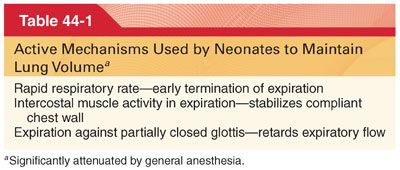a. To meet the elevated metabolic demand, neonatal cardiac output, relative to body weight, is twice that of the adult. This is achieved with a relatively rapid heart rate (140 beats per minute) because stroke volume cannot be significantly increased.
b. The neonatal circulation is characterized by centralization (increased peripheral vascular resistance and distribution of cardiac output primarily to vital organs), a situation comparable to an adult in compensated shock.
c. The structural and functional immaturity of the neonatal cardiovascular system severely limits the reserve that is available in the face of common perinatal and perioperative events such as hypovolemia, anesthetic-induced depression of contractility, relative bradycardia, and positive pressure ventilation–induced decreases venous return.
d. The marginal cardiovascular reserve of the neonate and leftward shift of the fetal hemoglobin dissociation curve are the rationale underlying the recommendation that the hematocrit be maintained at 30% or higher to prevent tissue ischemia in the newborn.
B. Respiratory Physiology of the Newborn
1. The respiratory system of a term neonate at birth is immature and postnatal development continues through early childhood (number of alveoli is reduced at birth and the ratio of alveolar surface area to body surface area is one-third that of the adult).
2. To satisfy increased oxygen demand, neonatal alveolar minute ventilation is twice that of the adult (increasing respiratory rate rather than tidal volume is the most efficient means to increase alveolar ventilation in the newborn).
3. The neonatal chest wall is more compliant and has less outward recoil than that of the adult (neonatal lung has a greater tendency to collapse and the infant is obliged to utilize active mechanisms to maintain normal lung volumes) (Table 44-1).

Stay updated, free articles. Join our Telegram channel

Full access? Get Clinical Tree


